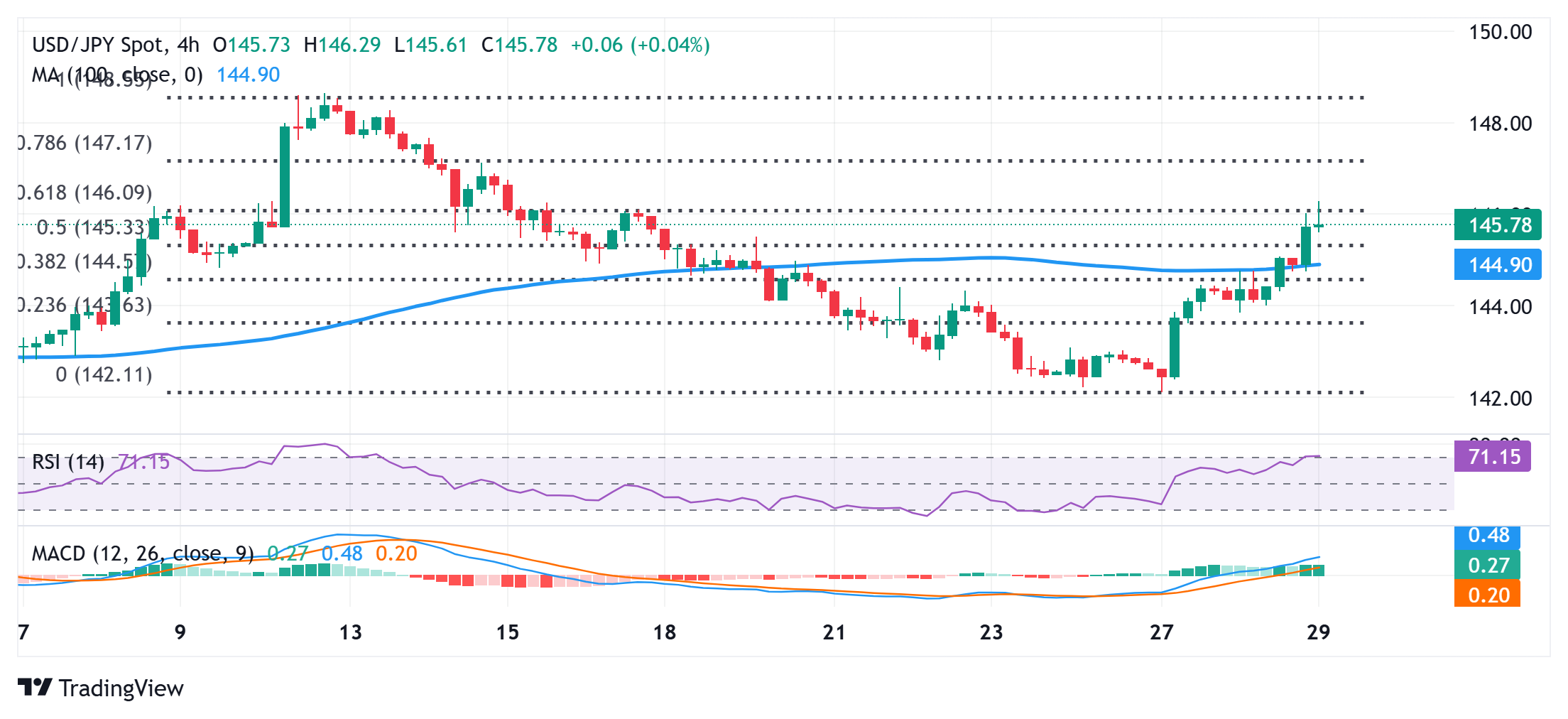Japanese Yen dives to nearly two-week low against USD on tariff news
- The Japanese Yen weakens across the board as the tariff-block news undermines safe-haven assets.
- The USD benefits from Wednesday’s hawkish FOMC Minutes and further supports the USD/JPY pair.
- The divergent BoJ-Fed policy expectations might keep a lid on any further gains for the currency pair.
The Japanese Yen (JPY) attracts heavy selling during the Asian session on Thursday in reaction to the news that a US federal court blocked President Donald Trump's "Liberation Day" tariffs from going into effect. The development boosts investors' confidence and triggers a fresh wave of the risk-on trade, which, in turn, weighs heavily on traditional safe-haven assets, including the JPY. Apart from this, the Federal Reserve's (Fed) wait-and-see approach remains supportive of a strong follow-through US Dollar (USD) move higher and assists the USD/JPY pair to prolong its weekly uptrend for the fourth consecutive day.
Moreover, demand at an auction of 40-year Japanese Government Bonds (JGB) on Wednesday fell to the lowest since July and pointed to worries about the debt load in Japan. This leads to a further steep decline in the longest JGB yields and turns out to be another factor driving flows away from the JPY. Meanwhile, the growing acceptance that the Bank of Japan (BoJ) will continue raising interest rates marks a big divergence in comparison to bets that the Fed will lower borrowing costs further in 2025. This might hold back traders from placing aggressive bearish bets around the lower-yielding JPY and cap the USD/JPY pair.
Japanese Yen bears seize control on news that a US federal court blocked Trump's tariffs
- US President Donald Trump’s proposed reciprocal trade tariffs were blocked by the Court of International Trade on Wednesday. The court ruled that the president overstepped his authority by imposing tariffs on goods from nearly every country in the world.
- The global risk sentiment gets a strong lift following the court's order, with Wall Street futures and equities across Asia rising sharply on Thursday. This undermines demand for traditional safe-haven assets, including the Japanese Yen, during the Asian session.
- Demand at an auction of Japan's longest-tenor bonds on Wednesday fell to the lowest since July and added to worries about the fiscal health of the economy. This further drives flows away from the JPY and pushes the USD/JPY pair higher for the fourth straight day.
- Meanwhile, traders have been pricing in the possibility that the Bank of Japan will hike interest rates again this year amid signs of broadening inflation in Japan. Hence, the focus will remain glued to the release of the Tokyo Consumer Price Index on Friday.
- Minutes of the Federal Reserve's May 6-7 policy meeting released on Wednesday revealed a consensus to maintain the wait-and-see approach on interest rates amid the uncertainty about the economic outlook and trade policies. The outlook supports the US Dollar.
- The CME Group's FedWatch Tool, however, indicates a greater chance that the US central bank might still deliver at least two 25 basis point rate cuts this year. This marks a big divergence in comparison to hawkish BoJ expectations and favors the JPY bulls.
- Market participants now look forward to Thursday's US economic docket – featuring the release of the Prelim Q1 GDP print, the usual Weekly Initial Jobless Claims, and Pending Home Sales data. This, along with Fedspeaks, might influence the USD demand.
USD/JPY needs to find acceptance above 146.00 to support prospects for further gains

From a technical perspective, the USD/JPY pair stalls its strong intraday move up near the 50% retracement level of the recent downfall from the monthly peak amid a slightly overbought Relative Strength Index (RSI) on hourly charts. That said, oscillators on the daily chart have just started gaining positive traction and support prospects for an extension of the weekly uptrend. Hence, any corrective pullback below the 145.35 region, or the 38.2% Fibonacci retracement level could be seen as a buying opportunity and remain limited near the 145.00 psychological mark. The latter is near the 200-period Simple Moving Average (SMA) on the 4-hour chart, which if broken will negate the near-term positive outlook.
On the flip side, the USD/JPY bulls might now await sustained strength and acceptance above the 146.00 mark before placing fresh bets. Spot prices might then accelerate the positive move towards the 146.70-146.75 intermediate hurdle en route to the 147.00 round figure and the next relevant barrier near the 147.60 supply zone. Some follow-through buying should allow the currency pair to climb further beyond the 148.00 mark, towards the monthly swing high, around the 148.65 region.
Tariffs FAQs
Tariffs are customs duties levied on certain merchandise imports or a category of products. Tariffs are designed to help local producers and manufacturers be more competitive in the market by providing a price advantage over similar goods that can be imported. Tariffs are widely used as tools of protectionism, along with trade barriers and import quotas.
Although tariffs and taxes both generate government revenue to fund public goods and services, they have several distinctions. Tariffs are prepaid at the port of entry, while taxes are paid at the time of purchase. Taxes are imposed on individual taxpayers and businesses, while tariffs are paid by importers.
There are two schools of thought among economists regarding the usage of tariffs. While some argue that tariffs are necessary to protect domestic industries and address trade imbalances, others see them as a harmful tool that could potentially drive prices higher over the long term and lead to a damaging trade war by encouraging tit-for-tat tariffs.
During the run-up to the presidential election in November 2024, Donald Trump made it clear that he intends to use tariffs to support the US economy and American producers. In 2024, Mexico, China and Canada accounted for 42% of total US imports. In this period, Mexico stood out as the top exporter with $466.6 billion, according to the US Census Bureau. Hence, Trump wants to focus on these three nations when imposing tariffs. He also plans to use the revenue generated through tariffs to lower personal income taxes.

